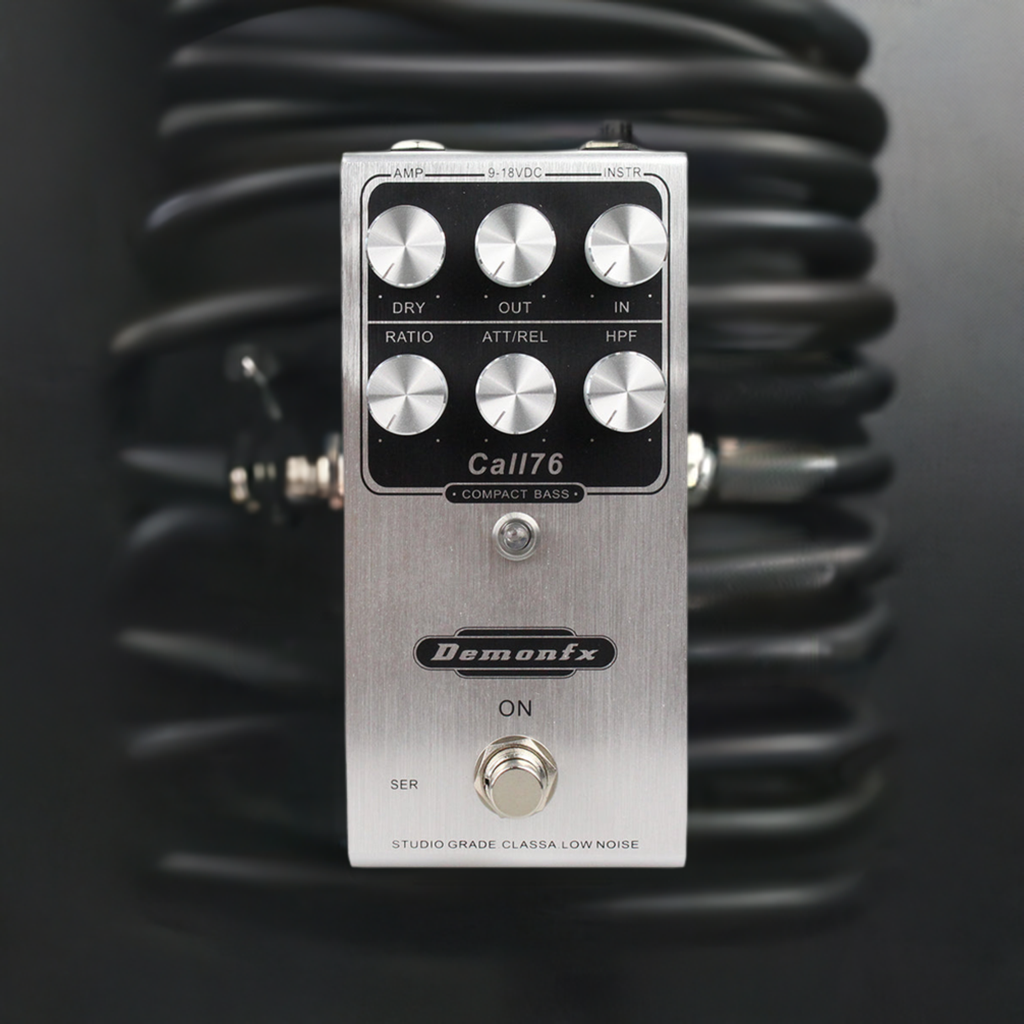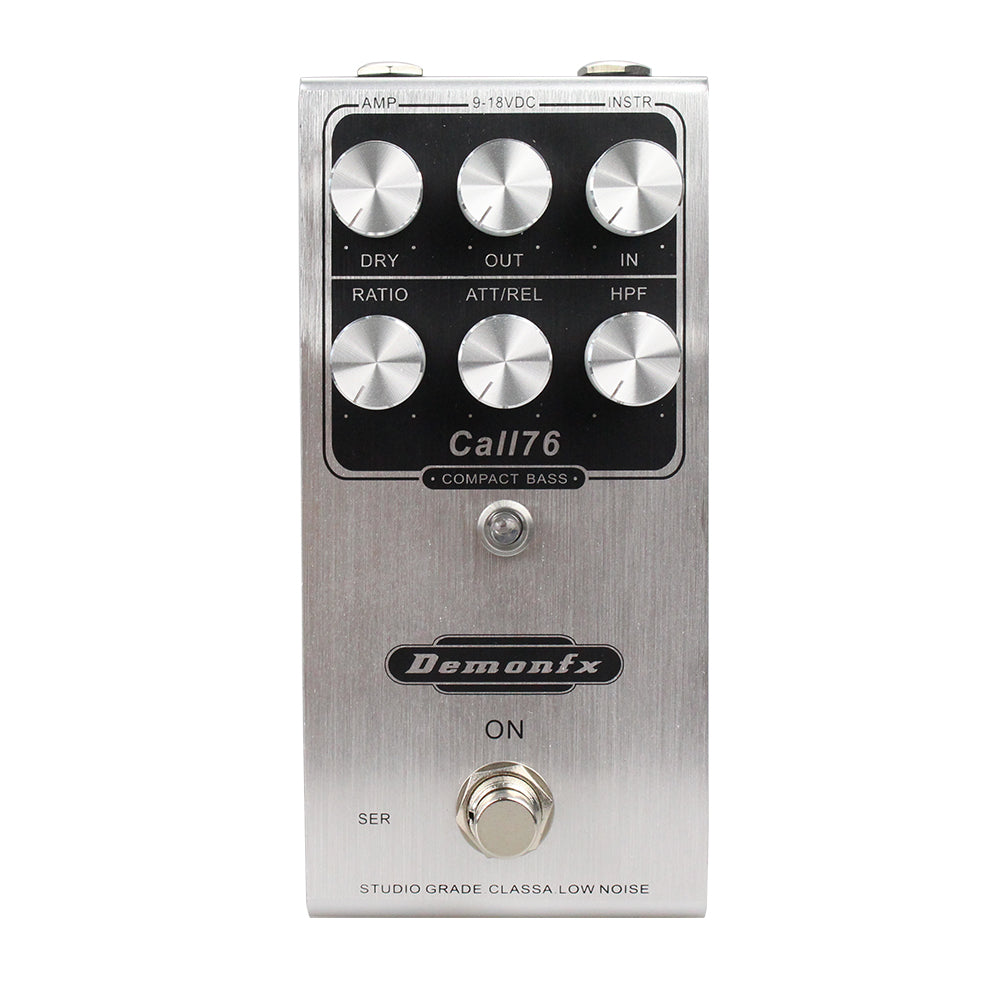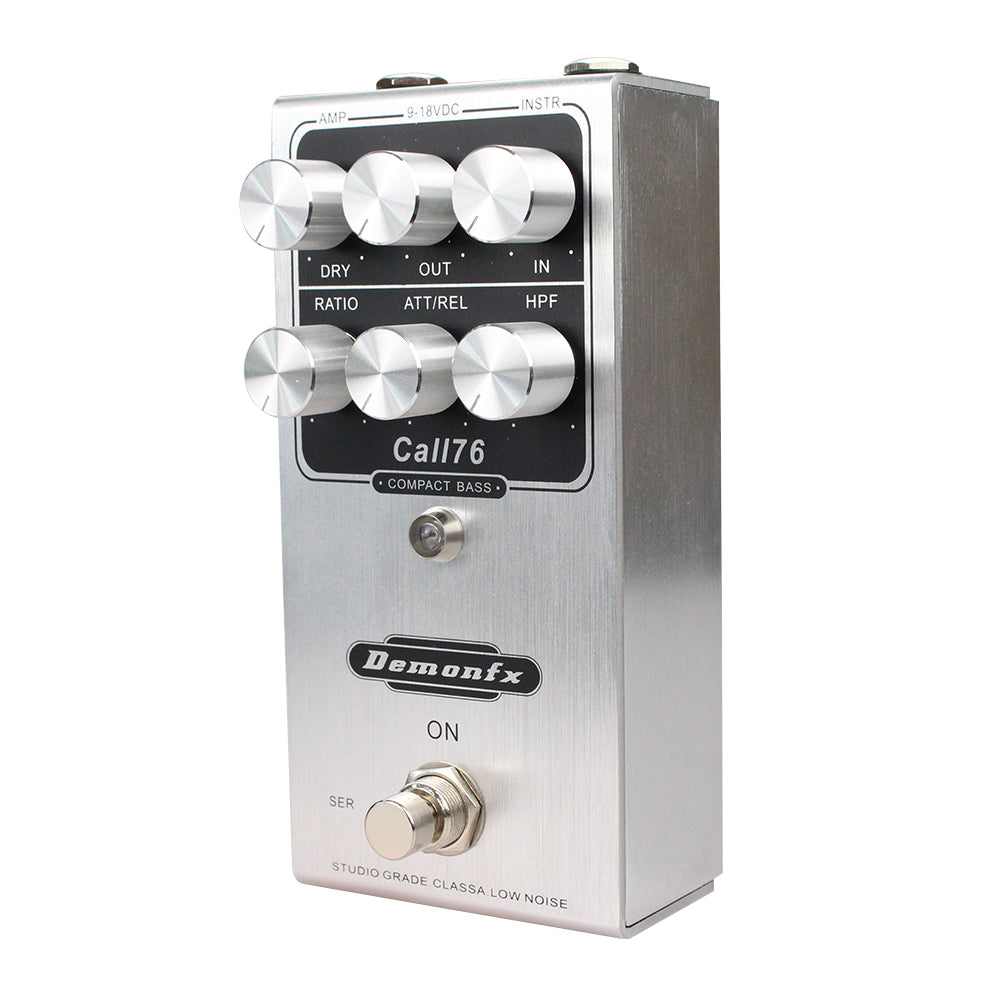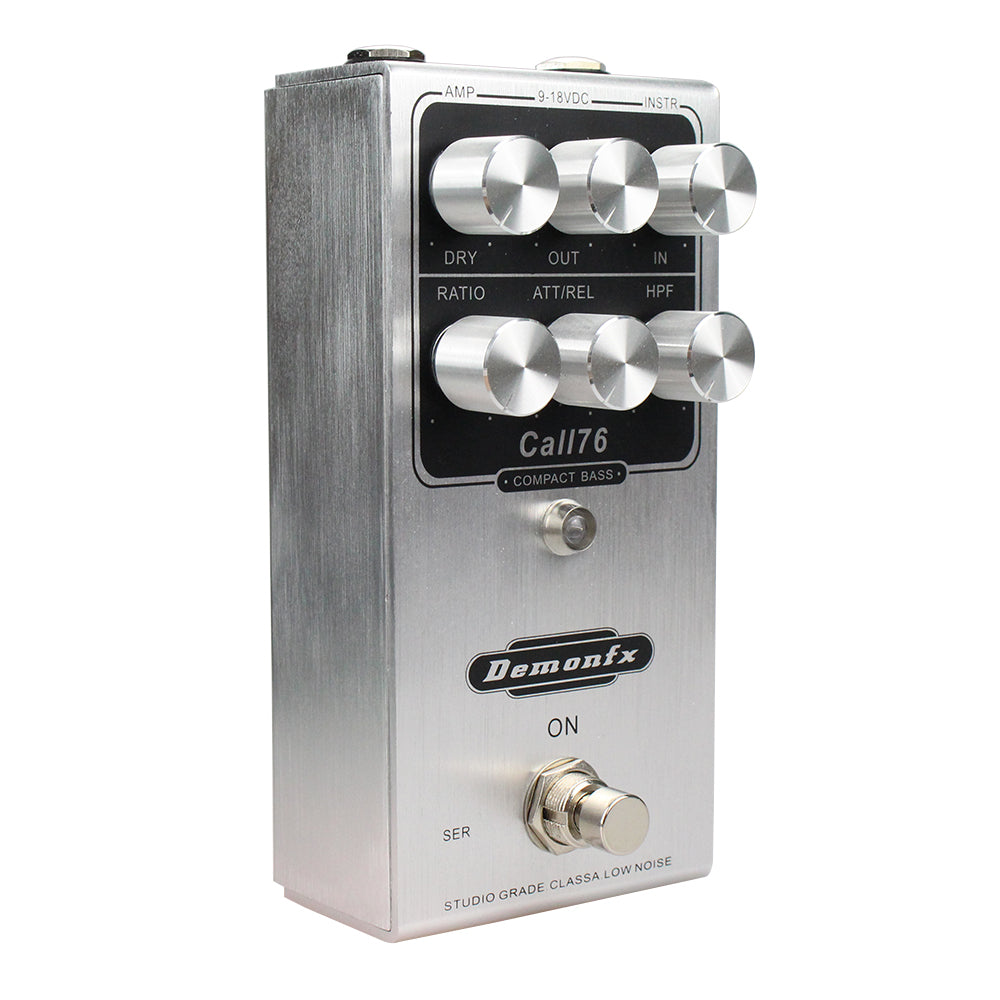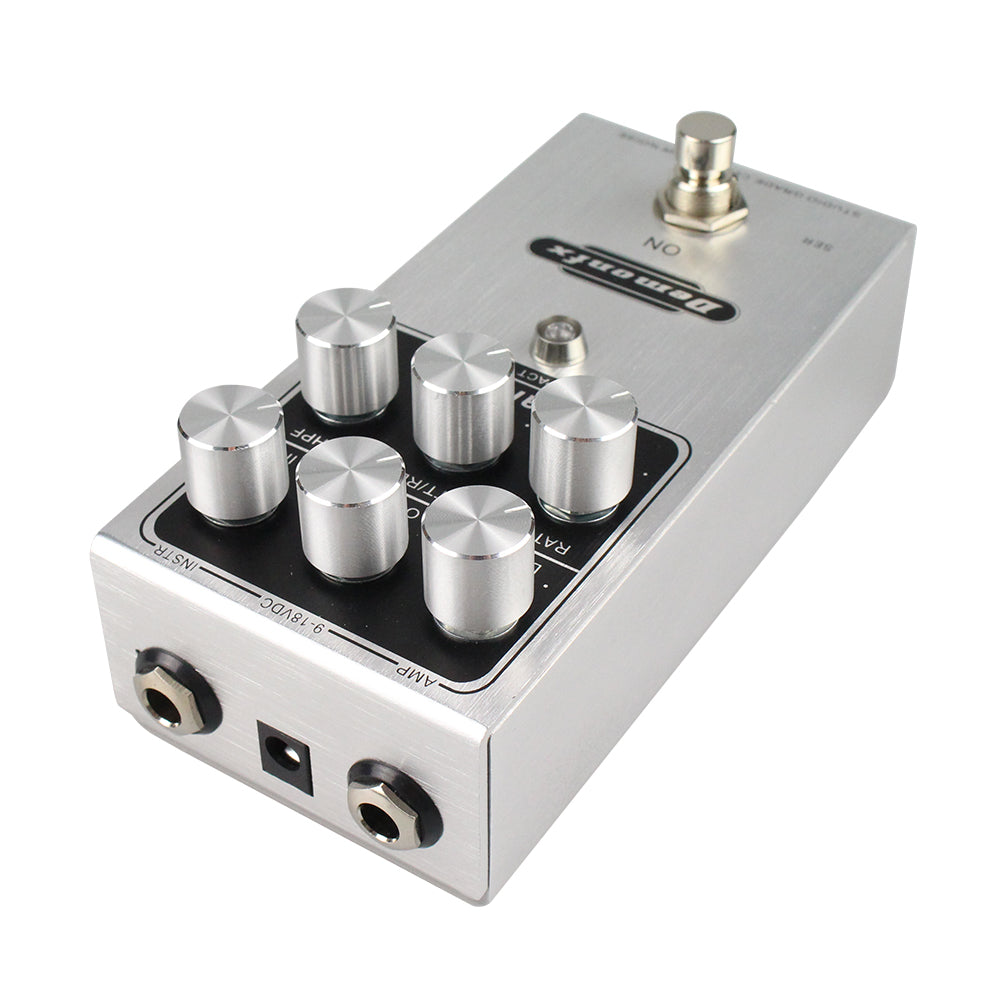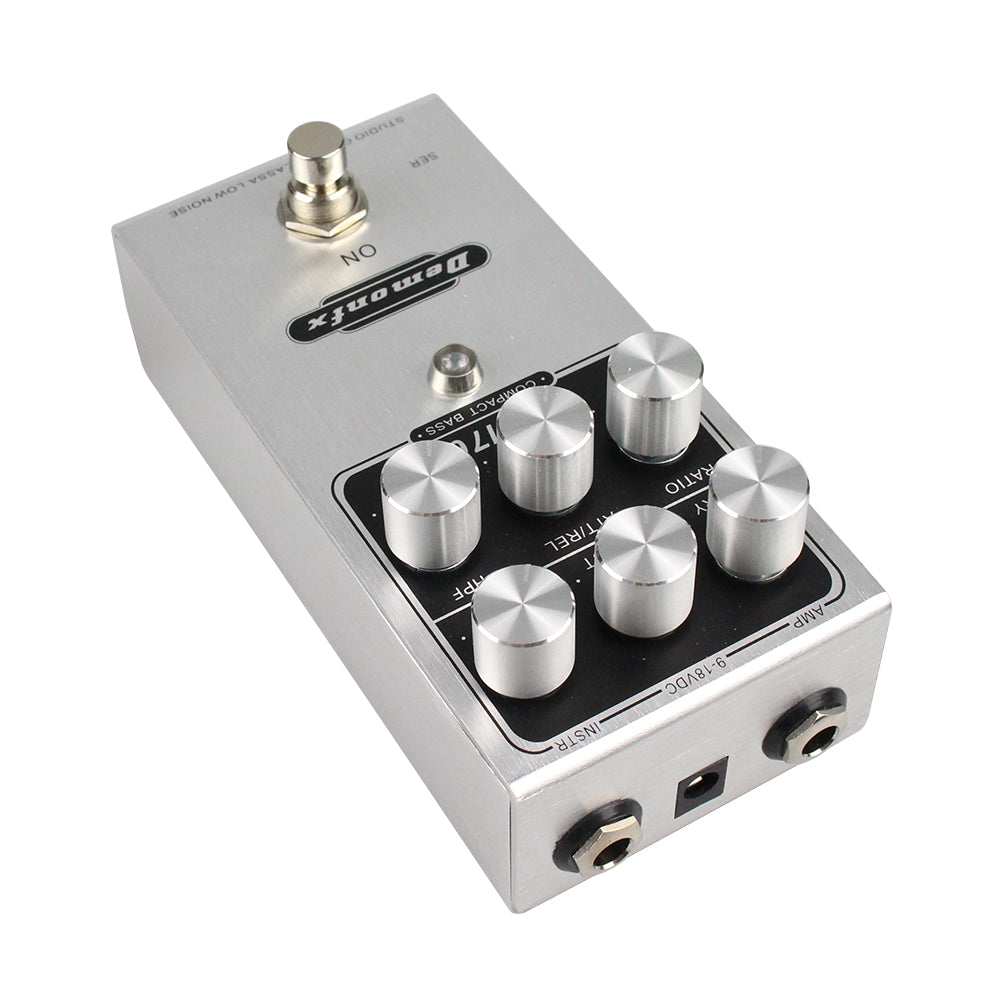Kairon Guitar Store
DemonFx Cali76 Compact Bass Compressor Pedal
DemonFx Cali76 Compact Bass Compressor Pedal
Couldn't load pickup availability
Based on ORIGIN EFFECTS Cali76 Compact Bass
The Call76 Compact Bass is an 1176-style studio-grade FET compressor,
complete with dedicated controls for parallel compression and sidechain filtering.
We’ve taken everything that was great about the original Call76, added new
features optimised for bass and compressed the whole lot down into a
pedalboard-friendly package!
A single combined Attack/Release control provides a continuous sweep of useful
settings while avoiding combinations that can result in ugly distortion artefacts
creeping into the lower registers.
In addition to this pedal’s low-noise circuitry and fast, musical FET response,
two special features lift the Call76 Compact Bass above the competition.
The first is the Dry Blend control, which lets you mix your dry signal back in
with your compressed signal for true parallel compression, an indispensable
studio recording technique. By combining the compressed and dry signals, you
get all of the tone thickening and increased sensitivity of the Cali76’s 1176-style
compression, while retaining the natural attack and dynamic expression in your
playing. It’s the ultimate in transparent compression – both fat and punchy at
the same time.
This pedal’s second secret weapon is also culled from the studio engineer’s
handbook. The Call76 Compact Bass allows you to rein in the amount of
compression applied to the lowest frequencies via a variable-frequency high-pass
filter placed in the compressor's sidechain. With the HPF control dialled in, the
compression ratio effectively becomes frequency dependant. The low strings
come back to life, adopting an extra weightiness, power and dynamic response,
while the higher strings are strictly controlled, preventing slapped and popped
notes from leaping out of the mix. This unique bass compressor is like having
your own studio engineer sat on your pedalboard!
Key Features:
• 100% Class-A discrete signal path
• Classic, ultra fast “FET” response
• Studio-grade discrete-transistor preamp
• Combined Attack/Release control
• Dedicated Ratio control
• Dry Blend control for parallel compression
• Variable-frequency sidechain filter (HPF) control
• Optimised for bass but can process any source
• High-current, low-noise electronics
• Ultra-wide frequency response
• Ultra-high input impedance
• Silent switching
• High-quality “signal-conditioning” bypass mode
• Premium components throughout
• Advanced power supply filtering and protection
• Flexible external power requirements (9-18V DC) Not included
• PSU Spec. 78mA @ 9V / 103mA @ 18V
• Designed in England
IN: The Call76 features a very nice studio-grade
input preamplifier. This works as an interface
between the guitar and the compressor
sections. In exactly the same way, a studio-engineer
will first amplify a dry guitar signal before applying
additional processing. The In control allows the
user to vary the gain of this preamplifier.
Turning the In control clockwise increases the
overall gain of the pedal. This also increases the
amount of compression. The guitar will
become increasingly touch sensitive as gain is
increased. Too much gain and the preamplifier will
clip and distort.Compression is greatly reduced at
lower gain settings, as much of the signal entering
the compressor section falls below the compressor's
internal threshold. Signal level must exceed this
threshold in order to initiate gain-reduction. So, at
lower gain settings, only the signal peaks are
compressed.
HPF: The HPF knob controls the cut-off frequency of a
high-pass filter positioned in the compressor's sidechain
circuitry. Attenuating low frequencies from the sidechain
has the effect of freeing up the low bass strings from
excessive compression. This fattens the tone of
your instrument and lets the low strings breathe. Dynamic
control is still fully active for the higher registers, meaning
that any slaps and pops are suitably taken care of!
Turning the HPF knob clockwise will raise the cut-off
frequency and free up more of the low end.
OUT: The Out control simply determines the level
of the signal present at the pedal's output. This can
be set in order to keep the overall
effected level close to that of the dry (bypass) signal.
Alternatively, the level can be increased to help
project a guitar solo.
DRY: The Dry control varies the amount of dry,
uncompressed signal present at the pedal's output,
thereby mixing the original,uneffected signal back
in with the compressed signal. You can adjust the
balance between the compressed and
uncompressed signals by adjusting the Out and
Dry knobs accordingly. Correct adjustments should
deliver the increased sensitivity and sustain of the
compressed signal, combined with the greater
dynamic integrity of the uncompressed signal.
RATIO: Turn the Ratio control clockwise to increase
the compression ratio. The Ratio control allows the
user to adjust the amount of gain reduction
applied for any given increase in guitar signal.
At the lowest ratio setting, doubling the input signal
(an increase of 100%)will result in the output
increasing by 19%. At the highest ratio setting, the
output would rise by only 3.5% for the same
increase in input signal. The latter case
represents "limiting". As was the case in the Urei
1176, changing the ratio setting also varies the
threshold level of the unit. This helps to keep the
output at a consistent level, regardless of settings.
In practice, lower Ratio settings will provide more
gentle, transparent compression, while higher Ratio
settings will deliver more aggressive compression
with a tightly controlled dynamic range – in other words,
the loudest and quietest notes you play will end up at
roughly the same level.
ATT/REL: Compressor attack and release controls are all too often
misunderstood, which is unfortunate as they are instrumental in
achieving a usable sound. In most cases attack and release parameters should
be adjusted to optimise the compressor's dynamic response
to that of a particular instrument. However, they can also be adjusted to create
strong dynamic effects. Incorrect settings can produce
nasty distortions and frequency-dependant artefacts.
The Att/Rel knob adjusts the two parameters simultaneously to offer the user a
choice of the most useful settings without any headaches!
All our favourite combinations are here. All the troublesome settings are
carefully side-stepped. Just adjust to taste!
The attack parameter can be thought of as the time taken for the compressor
to react to the presence of a signal, i.e. the delay from the
instant when you play the note to the moment the compressor actually reduces
the gain. The longer the attack time/delay, the more
pronounced the beginning of each note will sound. Increasing the attack time
highlights the percussive "snap" of picked, popped and slapped notes.
The release parameter can be thought of as setting the duration of the gain
reduction applied to the signal. This would be measured from
the time that compression is triggered to the point that the compressor has
returned to its idle state. For maximum effect when processing
bass guitar, the release time must be set so that the compressor responds fully
to every note played – in other words, short enough for the
compressor to fully recover in the time between one note ending and the next
note beginning.
Turning the Att/Rel knob clockwise will reduce the release time while increasing
the attack time, best for percussive playing. Rotating the
Att/Rel knob anti-clockwise will increase the release time while reducing the
attack time for a smoother, more “spongy” feel.
Share
